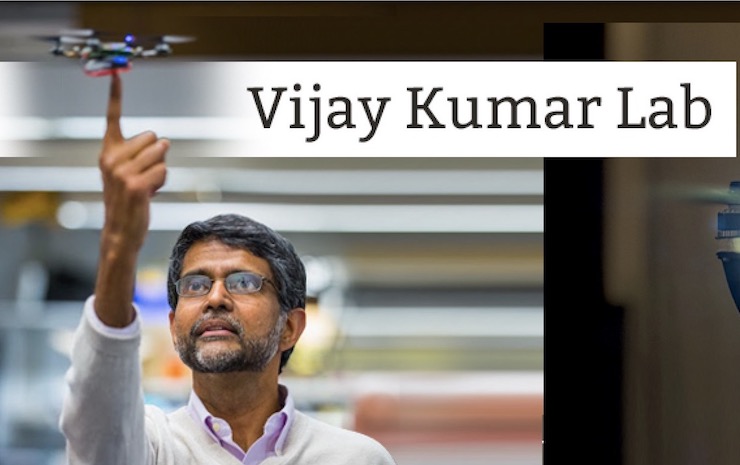
Swarms of miniature drones with LED lights have become common entertainment features. They have lit up the sky during the opening ceremonies of the 2018 Winter Olympics, the 2019 Super Bowl Half Time Show, performed along countless musicians like Drake and Celine Dion, have found a place in several of Disney’s theme park shows, and are frequently being used in place of firework displays. The way these drone swarms work is through carefully predetermined choreography and GPS. It looks like the swarm is effortlessly moving to create patterns, images, and words, but it takes a lot of programing to ensure control over each drone in the show. At the University of Pennsylvania a group of researchers have been looking to find a way to allow a swarm of drones to fly autonomously, regardless of GPS.
The project was developed by Giuseppe Loianno, Aaron Weinstein, and Adam Cho with the help of their mentor Vijay Kumar. Mr. Kumar is the Nemirovsky Family Dean of Penn Engineering and operates out of the aptly named Vijay Kumar Lab. As described on the lab’s website, researchers like Giuseppe, Aaron, and Adam work “on creating autonomous ground and aerial robots, designing bio-inspired algorithms for collective behaviors, and on robot swarms.” The Autonomous Micro UAVs project is an effort to create “autonomous flying robots that are able to navigate in complex, three-dimensional environments with or without GPS with applications to search and rescue, first response and precision farming. The robots are quadrotors with onboard sensors and processors customized for state estimation, control and planning.”
The drones range in size from 20grams (for indoor flight) to 2kg (suitable for indoor and outdoor operations). Each drone has a camera that scans the surface below it, computing what it sees from second to second. The drones also work off of Inertial Measurement Units (IMU) for navigation. An IMU is the same software that is in a smartphone that causes the screen orientation to change when the device is tilted one way or another. The IMU that is being used for these drones was developed by telecommunications experts Qualcomm, who also is partly funding this project.
To work, the drones first have to be arranged in a starting position. This position serves as the individual drone’s point of reference to determine it’s surroundings. Using the onboard camera, IMU, and complex algorithms that allow the drone to communicate with the others in the swarm, the drones can autonomously perform actions. In a test video Aaron first programed in a series of actions for the drones to complete. These actions were for the drones to transition from a straight line to a diamond, then to a diagonal line. He did not program the drone as to how they should carry out these maneuvers, simply for them to complete the tasks. By computing off of their original starting point, each individual drone preforms the task based on what is most logical for the swarm though communicating with each other. The drones do not realize that they are part of a swarm, rather that they have to preform a specific task a specific way in relation to what is around them. As Vijay explained, “The robots basically talk to each other. They each know where they’re going. They can use high-level algorithms to distribute themselves in complex ways to solve tasks.”
The implications of a swarm of autonomous flying drones is great. They can be used to map for precision agriculture. They can be used to survey construction sites, or post storm related destruction zones. Vijay went on to say, “Such devices can work as a group to canvas a wide area, capturing images and other data that would help emergency responders plot the next step.” Emergency crews are already using drones for search and rescue operations, but imagine how much more effective their efforts could be if the drones they are using can operate on their own, allowing human responders to better allocate their time.
The team has made great progress in designing the system. For now, they are working on some small kinks in the system, like how the drones can easily drift because of their light weight. Giuseppe also said they are looking to create a closed-loop system that would eliminate the need for the drones to communicate with a ground system. “Finally,” Giuseppe said, “we enhance the human-robot interaction aspect, allowing the team of robots to support missions in coordination with humans.” Yes, these drones are capable of autonomous operations, but the goal is for them to be used in ways to help humans, even alongside of them.
|